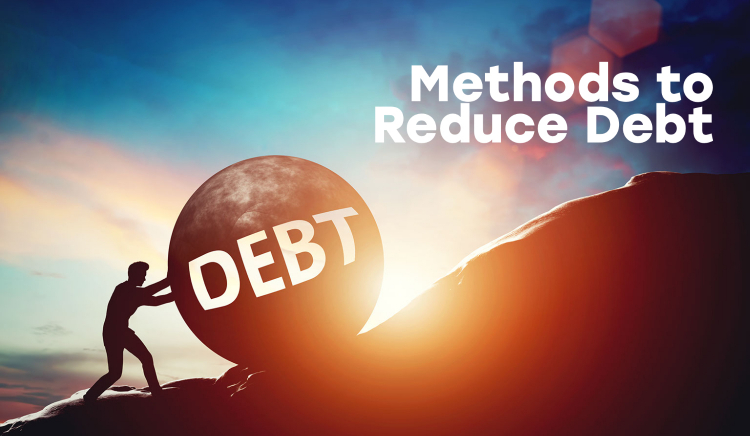Methods to Reduce Debt

Most individuals will have debt at least at some point in their lives, if not for most of their lives. The most challenging aspect of having debt is how to properly manage and maintain debt levels so that they are within one’s boundaries of income levels and affordability. Debt comes in many different instruments and lifespans, but the two main aspects to debt are the principal and interest amounts. When making a payment towards debt, that payment will be made towards two key aspects: the principal amount and the interest amount. The principal amount is the amount that will reduce the total debt balance, whereas the interest amount is what someone must pay the lender for borrowing the money. Interest payments are a percentage of the total loan amount, and so as the loan amount diminishes, so too does the interest amount.
Below we are going to go through some useful methods of how to reduce debt amounts and important factors to consider when paying down debt.
Use the Snowball Method
Where applicable, use what is known as the ‘snowball method’ of paying down debt. If an individual has multiple sources of debt (ie. Multiple credit cards, line of credit, other), the strategy is to first pay down the loan with the smallest balance. Paying off the loan with the smallest balance first will provide the individual with a sense of accomplishment and achievement, and this is a great first step in realizing that the debt can be paid off. Once the individual has paid down the loan with the smallest balance, then they can move onto to incrementally larger balance loans, until eventually, they are all paid off.
Another important factor to consider when paying off multiple loans, is to find the loan which has the highest interest percentage and pay that off first. Since each type of loan (credit card, line of credit, HELOC) will have varying interest rates, paying off the loan with the highest interest rate can potentially save an individual a lot of money.
Build a Budget
Everyone has two primary factors that make up their monthly cash flows: their income and their expenses. Creating a budget to assess how much money can be allocated from one’s income on a weekly, monthly, or annual basis is crucial to determining how quickly debt can be reduced. The first step in creating a budget is to assess what one’s typical expenses look like in a month and how that compares against one’s income. If the expenses are much lower than income, that’s great, that difference in amounts can then be used towards paying down debt. If the expenses are not lower than one’s income, certain expenses will need to be reevaluated and potentially removed monthly. Typically, the expenses which are most discretionary and leisurely should be removed first alongside any fixed payments (internet or phone bill) that can be reduced or removed altogether. Even reviewing smaller purchases (Starbucks, Netflix subscription, etc) can have a huge impact on one’s expenses and can add up quickly.
There is a common expression that ‘if your outflow exceeds your income, then your upkeep becomes your downfall’. This saying is a reminder that if one is consistently spending more money than they earn, then the maintenance of one’s lifestyle can become their main burden.
Meet Monthly Payments or Create Fixed Monthly Payments
There are two broad types of loans available to most consumers: a term loan, and a revolving loan.
With a term loan the funds are provided upfront and there is a repayment schedule with a set number of years until the debt is paid off. This repayment schedule is determined by the lender and typically involves a fixed dollar amount to be paid each month or year. Since it is a fixed dollar amount, the interest payments will be the highest in the earlier months or years, and as the debt is paid off, the interest payments will begin to diminish, and the principal portion will increase proportionately. A prime example of a term loan is a mortgage or a car loan.
With a revolving loan, the loan amount can be used at any point in time and the borrower is able to use either the full amount, partial amount, or no amount. As the revolving loan is paid off, the amount paid off is once again available for use. An example of a revolving loan is a credit card or a line of credit.
Below we are going to demonstrate how a $10,000 loan can be repaid within six months on a fixed-term schedule, meaning that the total payment amount made each month is the same. The interest rate in this example is 5% and the total monthly payments are $1,970. We can see that as the loan amount is reduced by the monthly principal payments, the interest amounts get smaller. This is because the interest amount is calculated as 5% of the loan amount, which over time begins to diminish.

In the example below, we look at what happens if an individual only pays the minimum interest payment required for the first two months and then gradually increases the monthly payments to eventually pay off the $10,000 loan in six months. By delaying the principal payments and only making interest payments for the first two months, we see that the individual ends up paying $2,500 in interest payments at the end of the six months, whereas in the first example the individual only pays $1,821. This roughly $700 difference in total payments is what can happen if monthly payments are missed, or payments are delayed until later. Therefore, it is important to try and set an equal cash flow amount that is paid each month and not to try and delay payments.

Speak with the Lender or Consider Debt Consolidation
Often if a borrower speaks with the lender there may be an opportunity to either reduce the interest rate or extend the life of the loan. Extending the life of the loan won’t reduce the debt amount, but it can help with monthly cash flows and reduce the amount payable each month.
Another available option is considering consolidating debt. Debt consolidation is offered by some lenders, and it is essentially one loan where an individuals’ multiple loans can be consolidated. The consolidation of these multiple loans into one giant loan usually involves a much lower interest rate and this will provide the borrower with savings in interest payments.
Consider Selling Personal Items and Belongings
Depending on how dire the debt situation is and how burdensome it has become on one’s life, there is no shame in selling personal items or belongings to gather cash to pay down debt. No one wants to give up their personal belongings and begin distributing pieces of their past, but this is an easy and relatively quick method of generating cash to pay off any existing loans. By selling personal items and using that amount to make a lump sum payment, this will greatly assist with reducing interest payments.
Final Takeaway
While debt can be a net positive to someone’s life, it can also bring many hardships and difficulties. If the stress of carrying too much debt becomes burdensome, some of these methods can be very useful in reducing the amount of debt and the amount of stress. Besides creating a budget and using helpful tactics such as debt consolidation, understanding how debt and loans work are paramount to ensuring they do not become overbearing, and the key is knowing the difference between principal and interest amounts.
There is one final expression that we find fitting – ‘greed pulls us forward, and pride blocks our retreat’. This is to say that the natural human ideology of wanting more causes us to continually spend and potentially take on more debt than we can handle, and if the debt becomes too burdensome, our pride of owning certain material possessions or living a certain lifestyle blocks our ability to escape. But in our opinion, having a specific lifestyle or owning certain material possessions do not outweigh the freedom that is associated with a weightless mindset.
 Research for today, Invest for tomorrow
Research for today, Invest for tomorrow
Chris White, CFA
Analyst for 5i Research Inc.


So true. Was about to finalize deal for a more expensive car. Probably think of clearing our debts first.
Thanks
Comments
Login to post a comment.